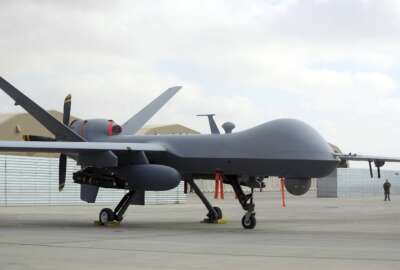Pentagon’s Replicator 2 to focus on drone defense
Defense Secretary Lloyd Austin said Replicator 2 will be part of the fiscal 2026 defense budget request.
The Pentagon’s next phase of its innovative Replicator initiative will focus on countering small drones at military installations across the globe, the department announced Monday.
Defense Secretary Lloyd Austin announced the Replicator 2 effort in a Sept. 27 memo, tasking Deputy Defense Secretary Kathleen Hicks and Vice Chairman of the Joint Chiefs of Staff Navy Adm. Christopher Grady with overseeing the development of the plan. The plan will be part of the fiscal 2026 defense budget request, according to the memo.
“The Department has been clear about applying Replicator’s focus to other capability areas, and the Department has been working for several months to assess validated joint capability gaps to determine where the Replicator process can provide the greatest value against our most urgent needs,” said Austin.
“As a result of that assessment, I have determined that Replicator 2 will tackle the warfighter priority of countering the threat posed by small uncrewed aerial systems (C-sUAS) to our most critical installations and force concentrations. I am confident the Replicator Initiative will complement and advance the significant C-sUAS work already underway in the DoD.”
Lloyd said he expects Replicator 2 to deliver enhanced protection against small uncrewed aerial systems within 24 months of Congress greenlighting the necessary funding.
Given the timeline, defense officials have until the end of 2024 to finalize the plan, but whether funding for the initiative is included in the 2026 President’s budget request and even the initiative’s future will depend on who occupies the White House next year.
Replicator, unveiled last August, is the Defense Department’s key initiative to quickly field thousands of all-domain, attritable autonomous systems by August 2025. Hicks said last month the military is already operating Replicator’s attritable autonomous systems in real-time across multiple regions worldwide.
Austin said the department is still on track to meet the fielding goal of Replicator by the August 2025 deadline.
The Defense Department secured about $500 million for Replicator in 2024 and requested the same amount for fiscal 2025 — Senate appropriators recommended that Congress fully fund the initiative in their version of the 2025 defense spending bill.
Austin said the Defense Innovation Unit will serve as the primary responsibility office for Replicator 2 — DIU Director Doug Beck will work closely with Under Secretary of Defense for Acquisition and Sustainment William LaPlante, who will serve as the C-sUAS principal staff assistant.
The military department will be responsible for developing, producing and fielding the technologies related to Replicator 2.
Doug Bush, the Army’s assistant secretary for acquisition, logistics, and technology, said during the CSIS event on Sept. 27 the service is leading the Replicator effort — the Army announced its plans to field more than 1,000 Switchblade 600 drones over the next year as part of the initiative earlier this year.
“Frankly, in terms of who’s going to deliver first — it’s us. We’re moving out. We’ve already got the contract in place. Production is underway. That was a program we were going to do anyway, but when the interest was expressed by the Replicator effort and DIU — thanks to their leadership we kind of blended the two efforts together, got more funding and have been able to go faster than we would have otherwise,” said Bush.
“I think it’s early days, but I think if done well and done in cooperation with the services, there’s a lot of potential there.”
While the goal of Replicator is to quickly field thousands of attritable systems, the broader objective is to create a process for acquiring new technologies more efficiently.
“The rapid prototyping and rapid fielding pathways are perfect for unmanned systems in this cost range. you can get a requirements document with enough specificity and then we can rapidly prototype and get to production, rather than slogging through the old process that was really more about avoiding cost risk than it was producing anything, frankly. We have those tools now. As long as we’re allowed to use them, we can do it,” said Bush.
Since the launch of the initiative last year, defense officials have been tight-lipped about the effort, leading to skepticism and doubts among lawmakers about whether the DoD has properly assessed the initiative’s capabilities and costs.
Copyright © 2024 Federal News Network. All rights reserved. This website is not intended for users located within the European Economic Area.






